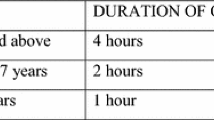Abstract
Objective
The use of seclusion or restraint (S/R) as an emergency medical intervention to assist patients in regaining behavioral control continues to be an area of interest and concern for the Joint Commission on the Accreditation of Healthcare Organizations (JCAHO), consistent with the ongoing concerns in the medical, patient advocate, legislative and legal communities. This study examined unit characteristics and the use of S/R in a VA facility with a secured, acute mental health unit before and after the promulgation of the JCAHO 2000 standards for utilization of S/R for behavioral health reasons.
Methods
Variables examined include patient acuity, patient census, number of admits, number of discharges, length of stay, number of nursing staff on duty, critical incidents and S/R hours per month.
Results
Results indicated S/R use began showing a notable decrease corresponding to the time that senior unit management began discussions of the new JCAHO standards. These reductions maintained statistical significance even after controlling for changes in unit environmental variables.

Similar content being viewed by others
References
Joint Commission on Accreditation of Healthcare Organizations: Comprehensive Accreditation Manual for Hospitals: The Official Handbook. Oakbrook Terrace, Illinois, Joint Commission Resources, 2000.
Allen MH, Currier GW: Use of restraints and pharmacotherapy in academic psychiatric emergency services. General Hospital Psychiatry 26:42–49, 2004.
Weiss EM: Deadly Restraint: A Nationwide Pattern of Death. Hartford Courant. October 11, 1998.
US General Accounting Office: Mental Health: Improper Restraint or Seclusion Use Places People at Risk. GAO publication HEH-99–176. Washington, DC, USGAO, 1999.
Mohr WK, Petti TA, Mohr BD: Adverse effects associated with physical restraint. Canadian Journal of Psychiatry 48:330–338, 2003.
Wynn R: Staff’s attitudes to the use of restraint and seclusion in a Norwegian university psychiatric hospital. Nordic Journal of Psychiatry 57:453–500, 2003.
Evans D, Fitzgerald M: The experience of physical restraint: a systematic review of qualitative research. Contemporary Nurse 13:126–135, 2002.
Bonner G, Lowe T, Rawcliffe D, et al.: Trauma for all: A pilot study of the subjective experience of physical restraint for mental health inpatients and staff in the UK. Journal of Psychiatric Mental Health Nursing 9:465–473, 2002.
Wynn R: Psychiatric inpatients’ experiences with restraint. Journal of Forensic Psychiatry & Psychology 15:124–145, 2004.
Sequeira H, Halstead S: The psychological effects on nursing staff of administering physical restraint in a secure psychiatric hospital: “When I go home, it’s then that I think about it”. British Journal of Forensic Practice 6:3–15, 2004.
Busch AB, Shore MF: Seclusion and restraint: A review of the recent literature. Harvard Review of Psychiatry 8:261–270, 2000.
Fisher WA: Restraint and seclusion: A review of the literature. American Journal of Psychiatry 151:1584–1591, 1994.
Morrison P, Lehane M: Staffing levels and seclusion use. Journal of Advanced Nursing 22:1193–1202, 1995.
de Cangas JPC: Nursing staff and unit characteristics: Do they affect the use of seclusion? Perspectives in Psychiatric Care 29:15–22, 1994.
Betemps EJ, Somoza E, Buncher CR: Hospital characteristics, diagnoses, and staff reasons associated with use of seclusion and restraint. Hospital and Community Psychiatry 44:367–371, 1993.
Schwab PJ, Lahmeyer CB: The uses of seclusion on a general hospital psychiatric unit. Journal of Clinical Psychiatry 40:228–231, 1979.
Brooks KL, Mulaik JS, Gilead MP, et al.: Patient overcrowding in psychiatric hospital units: Effects on seclusion and restraint. Administration and Policy in Mental Health 22:133–144, 1994.
Dietz PE, Rada RT: Seclusion rates and patient census in a maximum security hospital. Behavioral Sciences & the Law 1:89–93, 1983.
Kirkpatrick H: A descriptive study of seclusion: The unit environment, patient behavior, and nursing interventions. Archives of Psychiatric Nursing 3:3–9, 1989.
Forquer SL, Earle KA, Way BB et al.: Predictors of the use of restraint and seclusion in public psychiatric hospitals. Administration and Policy in Mental Health 23:527–532, 1996.
Tardiff K: Emergency control measures for psychiatric inpatients. Journal of Nervous and Mental Disease 169:614–618, 1981.
Plutchik R, Karasu TB, Conte HR et al.: Toward a rationale for the seclusion process. Journal of Nervous and Mental Disease 166:571–579, 1978.
Soloff PH: Behavioral precipitants of restraint in the modern milieu. Comprehensive Psychiatry 19:179–184, 1978.
Oldham JM, Russakoff LM, Prusnofsky L: Seclusion patterns and milieu. Journal of Nervous and Mental Disease 171:645–650, 1983.
Gorsuch RL: Unimult for Univariate and Multivariate Analyses. Altadena, CA, Unimult, 1991.
Acknowledgments
Institutional support for this study was provided by the Mental Illness Research Education and Clinical Center (MIRECC) of the VA Puget Sound Health Care System, Tacoma and Seattle, WA.
Author information
Authors and Affiliations
Corresponding author
Additional information
Previously presented as a poster session at the annual convention of the Association for Advancement of Behavior Therapy in New Orleans, LA. Meeting dates: November 18–21, 2004
Rights and permissions
About this article
Cite this article
Pollard, R., Yanasak, E.V., Rogers, S.A. et al. Organizational and Unit Factors Contributing to Reduction in the Use of Seclusion and Restraint Procedures on an Acute Psychiatric Inpatient Unit. Psychiatr Q 78, 73–81 (2007). https://doi.org/10.1007/s11126-006-9028-5
Published:
Issue Date:
DOI: https://doi.org/10.1007/s11126-006-9028-5




